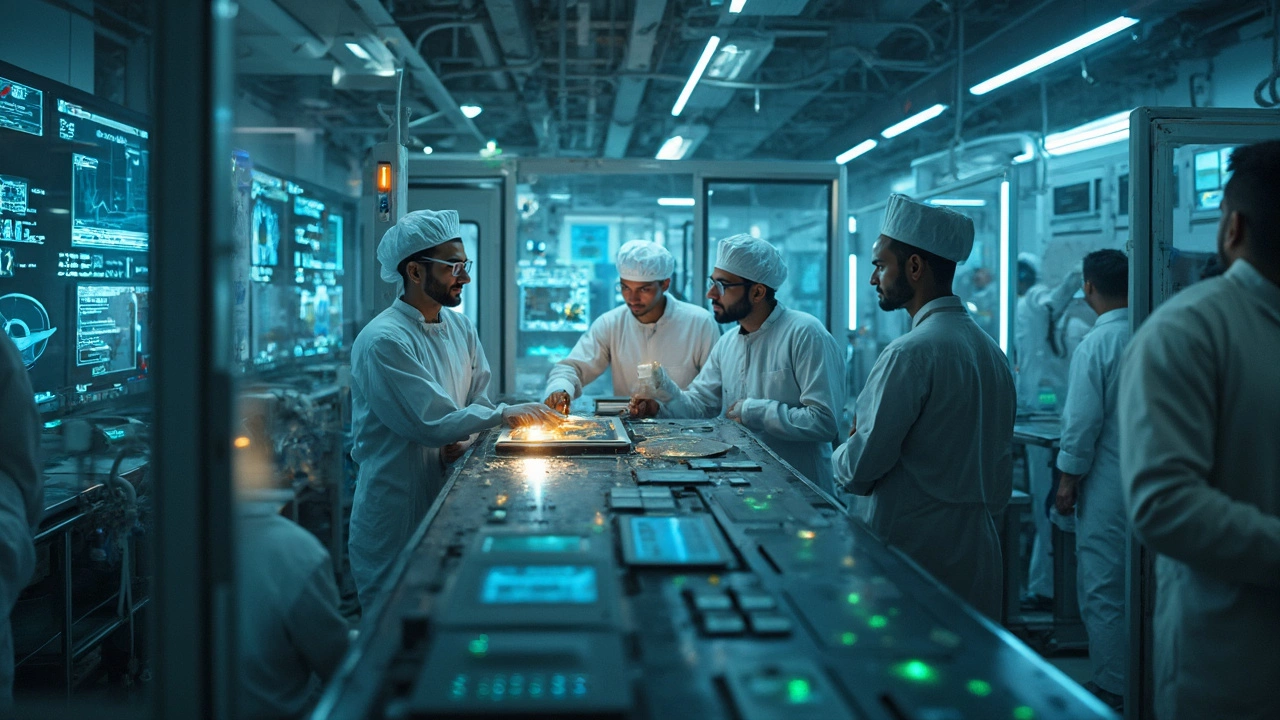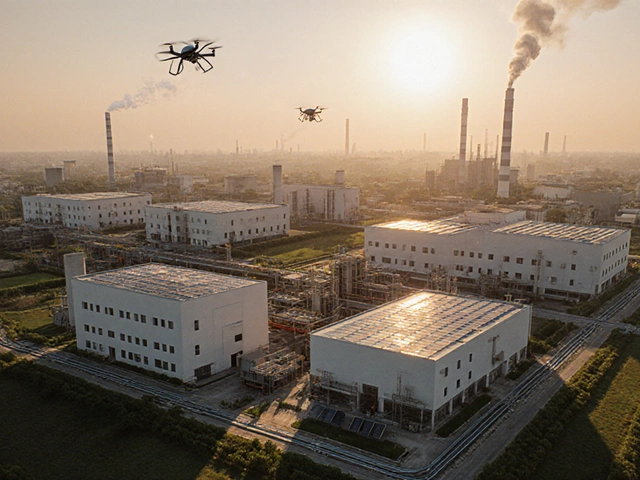Most Difficult Manufacturing Process: The Real Challenge Behind Government Schemes

If you ask anyone in manufacturing which process keeps them awake at night, you’ll hear one answer pop up more than most: chip manufacturing. Making computer chips isn’t just tough—it’s a delicate ballet of chemistry, physics, and pure precision. You’re looking at features measured in nanometers, higher than hospital-level cleanliness, and the kind of machines that cost more than a fleet of luxury cars.
Why should you care? Simple. This impacts everything—cars, phones, defense equipment, even your morning coffee machine. When governments roll out ambitious schemes to bring semiconductor production home, they’re betting big money on one of the trickiest, riskiest games in industry.
But fancy slogans and fat incentives only get you so far. The spark behind every successful chip plant is not just cash, but brainpower, tech muscle, and a supply chain so well-oiled that the tiniest hiccup can bring the whole show to a halt. Understanding the real challenges sheds a bright light on why government efforts matter—and where they usually hit a wall.
- The Hardest Nut to Crack: What Makes Chip Manufacturing So Tough?
- Government Schemes: Are They Doing Enough?
- Where Tech Meets Trouble: Real-World Challenges
- Tips for Surviving and Thriving in High-Stakes Manufacturing
The Hardest Nut to Crack: What Makes Chip Manufacturing So Tough?
Making computer chips isn’t like making just any product—you’re talking about a process where even a speck of dust can ruin a billion-rupee batch. The tiniest feature on these chips is about 2 nanometers wide. For comparison, a human hair is roughly 50,000 nanometers thick. It’s wild how small the details get. This is why chip factories, or fabs, are kept cleaner than hospital operating rooms.
To pull this off, you need gear that isn’t just expensive; it’s almost science fiction. One high-end extreme ultraviolet (EUV) lithography machine from ASML, a Dutch company that basically owns this market, costs more than ₹1,100 crore (about $150 million). Even then, just buying the machine doesn’t mean your problems are solved. You also need:
- Ultra-pure chemicals—regular materials just won’t cut it.
- Water that’s so pure it’s more filtered than what astronauts drink.
- Super stable power—fluctuations can wreck production instantly.
One area where things really get dicey is yield—how many usable chips you get out of a batch. If your yield is even a few percent lower than rivals, you’re bleeding money. Here’s a snapshot showing how yield can crash profits:
| Yield Rate | Chips per Batch | Profit per Batch |
|---|---|---|
| 95% | 950 | High |
| 85% | 850 | Average |
| 70% | 700 | Low / Negative |
If a single process step fails, the damage snowballs. Supply chain delays—for example, the rare gases like neon from Ukraine, or even ultrapure silicon wafers—can stop a whole facility in its tracks.
One more thing: It isn’t just about the hardware. You need armies of engineers, process experts, software whizzes, and machinists who’ve trained for years. That’s why the manufacturing process for chips is a giant leap harder (and more expensive) than most other industries. No wonder governments are scrambling to get in the game.
Government Schemes: Are They Doing Enough?
When it comes to the manufacturing process for semiconductors, no government wants to be left behind—especially after the global chip shortage that slowed down everything from car plants to smartphone launches. India, the US, EU, and China have all raced to throw big money at local production, but the results are mixed.
Just to give you an idea, the US passed the CHIPS and Science Act in 2022, putting $52 billion on the table to boost American-made chips. India launched a $10 billion incentive program for semiconductor and display manufacturing. But writing a check isn’t the same as making a factory produce at the world’s top level.
Here's a quick look at some of the biggest recent efforts:
| Region | Program | Funding | Key Focus |
|---|---|---|---|
| United States | CHIPS Act | $52 billion | Domestic chip manufacturing, research |
| India | Semicon India Program | $10 billion | Semiconductors, display manufacturing |
| European Union | European Chips Act | $47 billion (proposed) | Advanced chip production, R&D |
| China | Big Fund (IC Fund) | $39 billion (phase 1), ongoing | Foundries, design, materials |
Here’s the catch: Cash helps, but it’s only the start. The hardest part is talent. India, for example, is still building an ecosystem where experienced chip engineers and designers are rare compared to Taiwan or South Korea. Most countries also lack suppliers for key materials and parts. Even if you throw up shiny new labs, they don’t run themselves—you need trusted partners and a skilled team for the long haul. In some cases, local rules and red tape slow things down just when timing matters most.
- India’s best shot right now is attracting global giants like Foxconn and Micron, using incentives and fast-tracked policies. It’s promising, but take Micron’s Gujarat investment: the factory will take years to reach full speed, with most high-end work still being done outside India for now.
- American and European projects often get stuck on environmental permits and local opposition. Even Intel has seen chip plant delays in the US.
- China is speeding ahead but faces US export bans on advanced chipmaking gear, which changes the landscape overnight.
So, while the ambition’s big and the government support is louder than ever, the gritty reality is: money’s easy, world-class manufacturing is tough. Most regions are playing catch-up, and the results won’t show up for years. Anyone betting on quick wins is in for a bumpy ride.

Where Tech Meets Trouble: Real-World Challenges
Chip making isn’t just about putting stuff together. It’s a battlefield full of technical bumps that can trip up even the biggest names in the business. No matter how much you invest, one glitch on the line can turn your million-dollar setup into dead weight. Here’s what really messes with manufacturers, and why so many government schemes end up biting their nails.
First off, the machines that etch and build chips are mind-blowingly precise and expensive. A single extreme ultraviolet lithography (EUV) machine costs upwards of $150 million—and getting it to work at peak is harder than it sounds. TSMC, the world’s chip leader, needed years to master these. Fact is, just shipping and installing one takes a global team and weeks of effort. Even a speck of dust inside the lab can cause thousands of chips to fail.
Clean rooms crank up costs too. We’re talking air 10,000 times cleaner than a hospital operating room. Workers get decked out like astronauts, all for the sake of perfection. And just a minor hiccup in temperature, humidity, or air pressure can derail an entire production run.
Then there’s the brutal supply chain. Each manufacturing process for chips can use over a thousand different chemicals and dozens of rare metals. The 2021 chip shortage showed everyone how vulnerable the whole system is—a missed shipment of photoresist or a hiccup in neon gas supply (used for lasers) and you’re facing weeks of downtime.
Let’s lay out some challenges and their impact:
| Challenge | Impact on Manufacturing |
|---|---|
| EUV Machine Breakdown | Production line halted for days/weeks, multi-million dollar losses |
| Supply Chain Disruption | Shortage of key chemicals/parts, delays up to months |
| Clean Room Contamination | Thousands of chips scrapped, revenue loss |
| Electricity Fluctuations | Scrapped wafers, wasted resources |
| Skilled Worker Shortage | Slower ramp-up, more production errors |
Let’s not forget talent. Running a high-end chip fab needs engineers and technicians with rare skills. India, for example, is pouring money into training but still struggles to find enough chip wizards for their new plants. Even if you pay top rupee, the learning curve is steep.
Finally, tech changes fast. What’s cutting edge now might be outdated before you’ve run your first batch. Manufacturers walk a tightrope—invest too early and you risk losses, too late and you’re outpaced by rivals in South Korea or Taiwan. That’s why most new projects have backdoor plans, just in case the market zigs when they were hoping for a zag.
If you’re trying to get a handle on this game, don’t just watch the headlines when a new fab opens. The daily grind is where the real struggle—and the real test of government schemes—shows up.
Tips for Surviving and Thriving in High-Stakes Manufacturing
There’s no sugar-coating it: beating the odds in chip manufacturing (or any high-tech production) takes serious grit and a smart playbook. So, what works on the ground?
First, you need a killer team. The demand for skilled engineers in chip fabs is bonkers—TSMC and Intel both reported hiring sprees in 2024 when opening new facilities, and still struggled to fill roles. According to SEMI, the industry association, workforce gaps could delay production by over 20% at some sites.
Next up, be tight with your suppliers. One stuck shipment of ultrapure chemicals, and the whole line stops. The COVID-19 pandemic made it loud and clear: you need backup options for everything, from rare gases to basic silicon wafers.
- Map your supply chain, and always have alternative vendors.
- Invest in training programs for your people; don’t rely on outside hires only.
- Automate wherever possible. Machines don’t take coffee breaks or get tired.
- Use sensors and software to catch tiny defects before they snowball.
- Join government and industry working groups—policy moves fast and can boost your funding or help you dodge new rules.
Money always matters. Building a state-of-the-art chip fab costs at least $10 billion. India offered subsidies covering up to 50% of capital costs for first movers in its 2024 semiconductor push, but even then, companies said local hurdles—like slow land clearances—could sink budgets.
| Key Challenge | Industry Data (2024) |
|---|---|
| Skilled Worker Shortage | 22% of roles unfilled globally |
| Supply Chain Delays | Average delivery up 40% since 2020 |
| Rising Equipment Costs | Advanced lithography tools can cost $250M each |
| Project Overruns | Average fab build now overruns by 7 months |
Here’s a thing many ignore: local rules and environmental approvals can sneak up and really hurt. A smart move? Start the permitting process way before construction. It’s routine, not optional. Get people from compliance and legal involved early—don’t leave it until it’s a fire drill.
You can’t talk about thriving without mentioning quality. Modern chip fabs reject up to 30% of production in yield loss. Every percent up means millions gained. Use data analytics, machine vision, and lots of testing at every stage.
"The most successful manufacturers treat process automation and supply chain resilience as core to their survival, not just as a bonus," says Ajit Manocha, CEO of SEMI.
Bottom line: if you want to win in the manufacturing process game, double down on people, tech, and planning. Don’t just react—plan for surprise punches, and invest in the basics everyone else skips.



